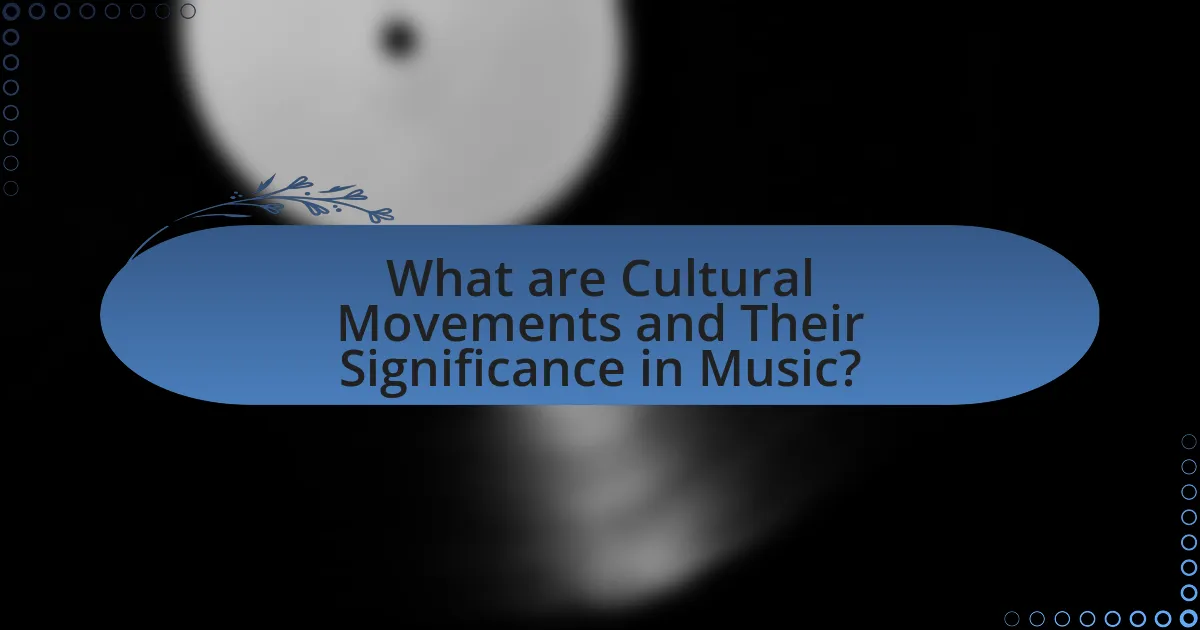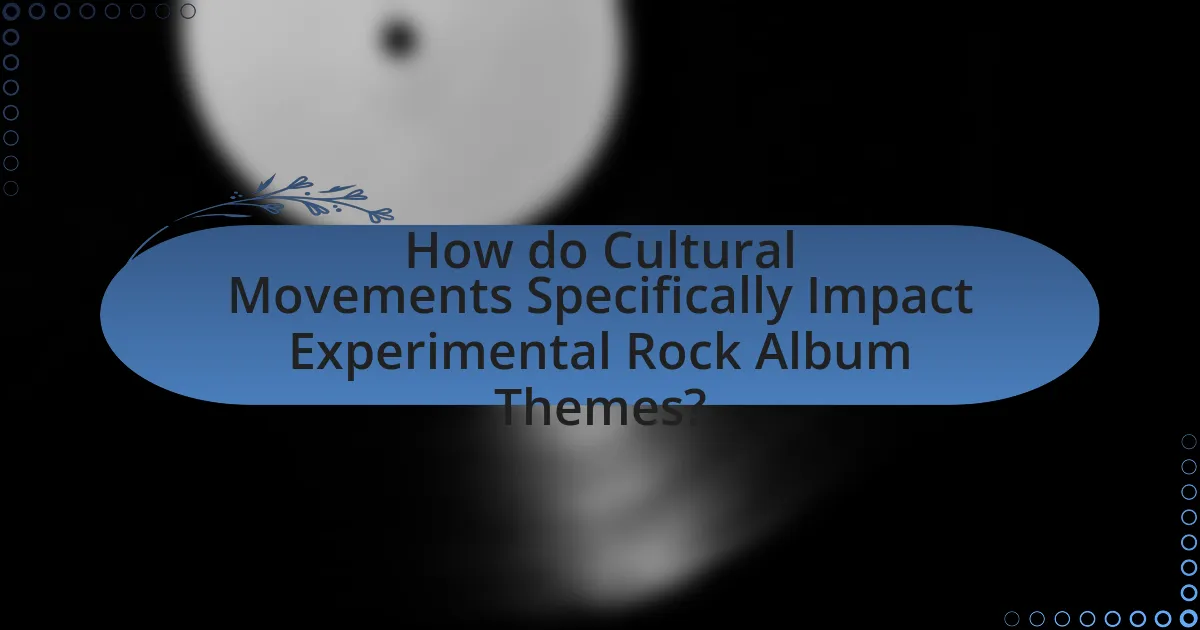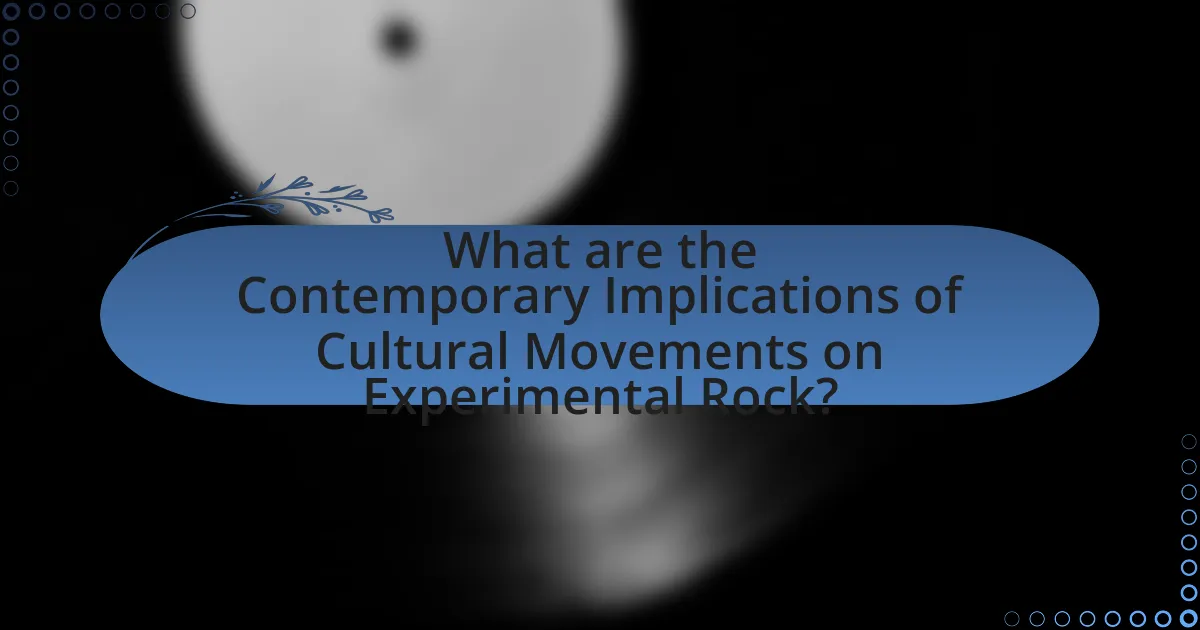The article analyzes the impact of cultural movements on experimental rock album themes, highlighting how collective social phenomena shape musical expression and innovation. It discusses historical examples, such as the Civil Rights Movement, the Punk Movement, and the counterculture of the 1960s, illustrating their influence on lyrical content, instrumentation, and overall artistic direction in experimental rock. The article also examines contemporary implications, emerging themes, and the role of artists’ backgrounds in interpreting cultural movements, providing a comprehensive understanding of the dynamic relationship between societal changes and music.

What are Cultural Movements and Their Significance in Music?
Cultural movements are collective social phenomena that reflect shared values, beliefs, and artistic expressions within a specific time and place, significantly influencing music. These movements, such as the Civil Rights Movement or the Punk Movement, shape musical genres, inspire lyrical content, and foster new sounds, thereby altering the landscape of music history. For instance, the Punk Movement of the 1970s challenged mainstream music norms, leading to the emergence of raw, unfiltered sounds and politically charged lyrics, which can be seen in the works of bands like The Sex Pistols and The Clash. This demonstrates how cultural movements not only provide a backdrop for musical innovation but also serve as a catalyst for social change, making them essential to understanding the evolution of music.
How do cultural movements influence artistic expression?
Cultural movements significantly influence artistic expression by shaping the themes, styles, and messages conveyed in art. For instance, the counterculture movement of the 1960s led to a surge in experimental rock music, where artists like The Beatles and Jimi Hendrix incorporated social and political commentary into their work, reflecting the era’s values and struggles. This influence is evident in the lyrics and soundscapes of albums such as “Sgt. Pepper’s Lonely Hearts Club Band,” which embraced psychedelic elements and challenged traditional norms. Such artistic expressions serve as a mirror to the cultural zeitgeist, demonstrating how societal changes can inspire innovation and creativity in the arts.
What are some historical examples of cultural movements impacting music?
Cultural movements have significantly impacted music throughout history, with notable examples including the Harlem Renaissance, the counterculture movement of the 1960s, and the punk rock movement. The Harlem Renaissance, which flourished in the 1920s, brought African American cultural expressions to the forefront, influencing jazz and blues music, as seen in the works of artists like Duke Ellington and Louis Armstrong. The 1960s counterculture movement, characterized by anti-establishment sentiments, led to the rise of rock music that incorporated themes of social change, as exemplified by bands like The Beatles and Jefferson Airplane. The punk rock movement of the 1970s emerged as a reaction against mainstream music, promoting DIY ethics and political messages, with bands like The Ramones and Sex Pistols embodying this shift. Each of these movements not only shaped musical styles but also reflected and influenced societal attitudes and changes.
How do cultural movements shape the themes in various music genres?
Cultural movements significantly shape the themes in various music genres by influencing the social, political, and emotional contexts in which music is created and consumed. For instance, the civil rights movement in the 1960s inspired genres like soul and funk, leading to themes of empowerment and resistance in songs by artists such as James Brown and Aretha Franklin. Similarly, the punk movement of the 1970s introduced themes of rebellion and anti-establishment sentiments in rock music, exemplified by bands like The Sex Pistols and The Clash. These movements provide a framework for artists to express collective experiences and societal issues, thereby embedding cultural narratives into the fabric of music genres.
What role does experimental rock play in the context of cultural movements?
Experimental rock serves as a catalyst for cultural movements by challenging conventional musical norms and reflecting societal changes. This genre often incorporates diverse influences, pushing boundaries and encouraging innovation, which resonates with the ethos of various cultural shifts, such as the counterculture of the 1960s and the punk movement of the 1970s. For instance, bands like The Velvet Underground and Pink Floyd used experimental rock to address themes of alienation and social critique, thereby influencing the cultural landscape and inspiring subsequent generations of artists. The genre’s emphasis on artistic expression and exploration aligns with the values of movements advocating for social change, making it a significant force in shaping cultural narratives.
How has experimental rock evolved alongside cultural shifts?
Experimental rock has evolved significantly alongside cultural shifts by incorporating diverse influences and responding to societal changes. For instance, the genre emerged in the 1960s during a period of counterculture, with bands like The Velvet Underground and Pink Floyd pushing boundaries through innovative sounds and themes that reflected the era’s social upheaval. As cultural movements such as feminism and civil rights gained momentum in the 1970s and 1980s, artists like Laurie Anderson and Sonic Youth integrated these themes into their music, using experimental techniques to challenge norms and provoke thought. The rise of digital technology in the 1990s further transformed experimental rock, allowing artists like Radiohead to explore new sonic landscapes and address contemporary issues such as globalization and environmental concerns. This ongoing evolution illustrates how experimental rock not only mirrors cultural shifts but also actively engages with them, creating a dynamic dialogue between music and society.
What are the defining characteristics of experimental rock music?
Experimental rock music is characterized by its innovative approach to sound, structure, and instrumentation, often pushing the boundaries of traditional rock. This genre frequently incorporates unconventional song forms, diverse influences from other musical styles, and the use of non-standard instruments or technology, such as synthesizers and tape loops. Notable examples include the works of bands like The Velvet Underground and Radiohead, which exemplify the blending of rock with avant-garde elements, challenging listeners’ expectations and expanding the genre’s artistic scope.

How do Cultural Movements Specifically Impact Experimental Rock Album Themes?
Cultural movements significantly influence experimental rock album themes by shaping the artistic expression and lyrical content of the music. For instance, the counterculture movement of the 1960s led to albums like Pink Floyd’s “The Piper at the Gates of Dawn,” which incorporated themes of psychedelic experiences and social rebellion, reflecting the era’s quest for freedom and exploration of consciousness. Similarly, the punk movement in the 1970s inspired bands like The Velvet Underground to address themes of alienation and societal critique, mirroring the disillusionment felt by youth at that time. These examples illustrate how cultural contexts directly inform the thematic direction of experimental rock, making the genre a reflection of its societal backdrop.
What themes are commonly found in experimental rock albums influenced by cultural movements?
Common themes found in experimental rock albums influenced by cultural movements include social commentary, identity exploration, and the critique of mainstream culture. Social commentary often reflects the political and social issues of the time, such as anti-war sentiments during the Vietnam War era, as seen in albums like “The Dark Side of the Moon” by Pink Floyd. Identity exploration is prevalent, with artists delving into personal and collective identities, often influenced by movements like feminism and rights, exemplified in works by artists such as David Bowie. Additionally, the critique of mainstream culture manifests through avant-garde sounds and unconventional structures, challenging societal norms and expectations, as demonstrated in the works of bands like The Velvet Underground. These themes collectively illustrate how cultural movements shape the artistic expressions within the experimental rock genre.
How do social issues reflected in cultural movements manifest in album lyrics?
Social issues reflected in cultural movements manifest in album lyrics through explicit themes, imagery, and narratives that address societal challenges. For example, the punk rock movement of the 1970s often highlighted issues such as political corruption, economic disparity, and social injustice, with bands like The Clash using their lyrics to critique government policies and advocate for change. Similarly, the feminist movement influenced artists like PJ Harvey, whose lyrics explore gender inequality and female empowerment, directly addressing the struggles faced by women in society. These examples illustrate how cultural movements shape the lyrical content of albums, making social commentary a central element of the music.
What role does instrumentation play in conveying themes influenced by cultural movements?
Instrumentation plays a crucial role in conveying themes influenced by cultural movements by shaping the emotional and aesthetic experience of the music. For instance, the use of unconventional instruments or techniques can reflect the socio-political climate of a specific era, such as the incorporation of electronic sounds in the 1960s counterculture, which symbolized rebellion and innovation. Historical examples include the use of distorted guitars and synthesizers in punk and new wave music, which articulated themes of disillusionment and resistance. These instrumental choices not only enhance the narrative of the music but also resonate with the cultural zeitgeist, making the themes more relatable and impactful to the audience.
How do artists interpret cultural movements in their experimental rock albums?
Artists interpret cultural movements in their experimental rock albums by integrating themes, sounds, and lyrical content that reflect societal changes and ideologies. For instance, the counterculture of the 1960s influenced bands like The Velvet Underground, whose album “The Velvet Underground & Nico” addressed topics such as drug use and sexual liberation, mirroring the era’s social upheaval. Similarly, the punk movement of the 1970s saw bands like Sonic Youth incorporate dissonant sounds and anti-establishment lyrics, representing a rejection of mainstream culture. These interpretations often serve as a commentary on contemporary issues, allowing artists to engage with and critique the cultural landscape through their music.
What are some notable experimental rock albums that reflect specific cultural movements?
Notable experimental rock albums that reflect specific cultural movements include “The Velvet Underground & Nico” by The Velvet Underground, which embodies the countercultural movement of the 1960s, addressing themes of drug use and sexuality. Another significant album is “OK Computer” by Radiohead, which reflects the anxieties of the late 1990s and early 2000s regarding technology and alienation. Additionally, “The Dark Side of the Moon” by Pink Floyd captures the existential concerns of the 1970s, exploring themes of mental health and societal pressures. Each of these albums not only showcases innovative musical techniques but also serves as a commentary on the cultural zeitgeist of their respective eras.
How do artists’ backgrounds influence their interpretation of cultural movements?
Artists’ backgrounds significantly influence their interpretation of cultural movements by shaping their perspectives, experiences, and emotional responses. For instance, an artist raised in a politically charged environment may incorporate themes of social justice and activism into their work, reflecting the cultural movements surrounding them. Historical context plays a crucial role; artists from marginalized communities often draw upon their unique experiences to critique dominant narratives, as seen in the works of musicians like Gil Scott-Heron, who addressed racial inequality during the civil rights movement. Additionally, cultural heritage can inform an artist’s stylistic choices and thematic focus, as demonstrated by the incorporation of traditional elements in the works of artists like Youssou N’Dour, who blends African rhythms with contemporary genres to comment on globalization and cultural identity. Thus, an artist’s background not only informs their individual expression but also serves as a lens through which they interpret and engage with broader cultural movements.

What are the Contemporary Implications of Cultural Movements on Experimental Rock?
Contemporary cultural movements significantly influence experimental rock by shaping its themes, aesthetics, and production techniques. For instance, the rise of social justice movements has led to a greater emphasis on lyrical content that addresses issues such as inequality and identity, reflecting the concerns of modern audiences. Additionally, the integration of technology and digital media, driven by cultural shifts towards online platforms, has transformed how experimental rock is produced and distributed, allowing for more diverse sounds and collaborations. This evolution is evident in the works of artists like Björk and Radiohead, who incorporate elements from various cultural movements into their music, thereby expanding the genre’s boundaries and relevance in today’s society.
How are current cultural movements shaping new experimental rock themes?
Current cultural movements are significantly shaping new experimental rock themes by influencing lyrical content, musical styles, and the overall aesthetic of the genre. For instance, the rise of social justice movements has led artists to incorporate themes of activism and identity politics into their music, reflecting societal issues such as racial inequality and climate change. This is evident in albums like “Black Country, New Road’s” “Ants From Up There,” which explores personal and collective experiences in the context of contemporary societal challenges. Additionally, the integration of diverse musical influences, such as electronic and hip-hop elements, showcases the impact of globalization and the blending of genres, further pushing the boundaries of traditional rock. This evolution is supported by the increasing collaboration between artists from various backgrounds, fostering innovation and experimentation within the genre.
What are the emerging themes in recent experimental rock albums?
Emerging themes in recent experimental rock albums include the exploration of identity, mental health, and socio-political commentary. Artists are increasingly delving into personal narratives that reflect broader societal issues, such as the impact of technology on human relationships and the climate crisis. For instance, albums like “Anima” by Thom Yorke address anxiety and existential dread, while “The Future Bites” by Steven Wilson critiques consumer culture. These themes resonate with listeners, as they mirror contemporary cultural movements focused on self-awareness and activism, demonstrating how experimental rock serves as a platform for both personal and collective expression.
How do modern artists address contemporary social issues through their music?
Modern artists address contemporary social issues through their music by incorporating themes of activism, personal narratives, and societal critique into their lyrics and sound. For instance, artists like Billie Eilish and Childish Gambino tackle topics such as mental health, racial inequality, and climate change, using their platforms to raise awareness and provoke thought. Eilish’s song “Your Power” discusses the abuse of power and its impact on individuals, while Gambino’s “This Is America” critiques gun violence and systemic racism in the United States. These examples illustrate how music serves as a vehicle for social commentary, reflecting and influencing public discourse on pressing issues.
What can we learn from the relationship between cultural movements and experimental rock?
The relationship between cultural movements and experimental rock reveals how societal changes influence musical innovation. For instance, the counterculture of the 1960s, characterized by anti-establishment sentiments, directly inspired experimental rock bands like The Velvet Underground and Pink Floyd, who incorporated unconventional sounds and themes into their music. This connection illustrates that as cultural movements challenge norms, they encourage artists to explore new artistic boundaries, resulting in a genre that reflects and critiques contemporary issues. The evolution of experimental rock, therefore, serves as a sonic representation of the cultural zeitgeist, demonstrating the interplay between music and the socio-political landscape.
How can understanding this relationship enhance our appreciation of music?
Understanding the relationship between cultural movements and experimental rock album themes enhances our appreciation of music by providing context that deepens emotional and intellectual engagement. This context allows listeners to recognize how societal changes, such as the counterculture of the 1960s, influenced the thematic elements and artistic choices in albums like Pink Floyd’s “The Dark Side of the Moon.” By analyzing these connections, listeners can appreciate the layers of meaning in the music, leading to a richer listening experience and a greater understanding of the artists’ intentions and the historical significance of their work.
What are some best practices for analyzing themes in experimental rock albums?
Best practices for analyzing themes in experimental rock albums include examining lyrical content, instrumentation, and production techniques. Analyzing lyrical content involves identifying recurring motifs and narratives that reflect cultural or personal experiences, as seen in albums like “The Dark Side of the Moon” by Pink Floyd, which explores themes of mental health and existentialism. Instrumentation analysis focuses on how unconventional sounds and structures contribute to thematic depth, such as the use of dissonance in Sonic Youth’s work to convey chaos. Production techniques, including layering and effects, can also enhance thematic expression, as demonstrated in Radiohead’s “OK Computer,” which critiques modernity and alienation. These practices provide a comprehensive understanding of how experimental rock albums engage with and reflect cultural movements.